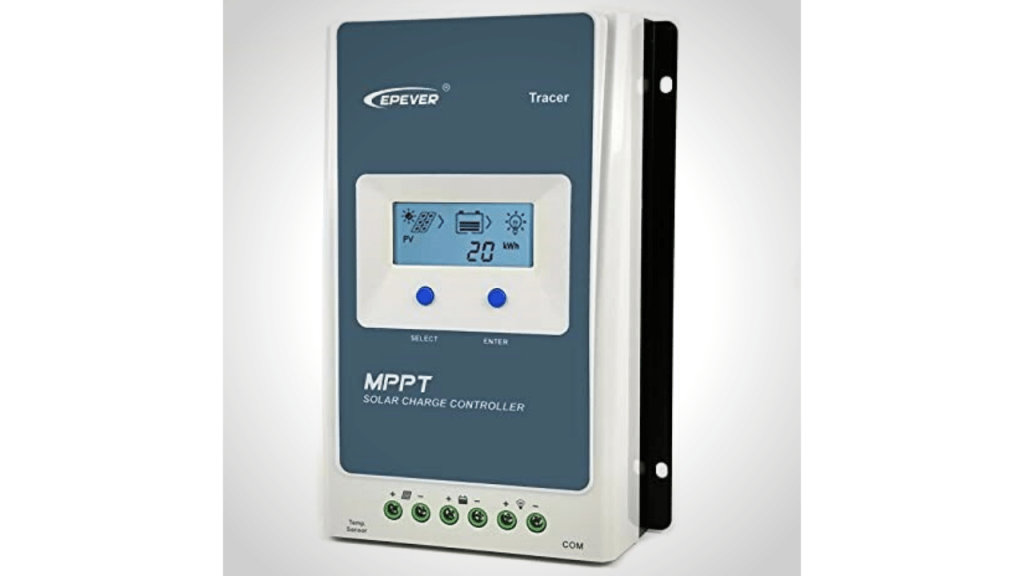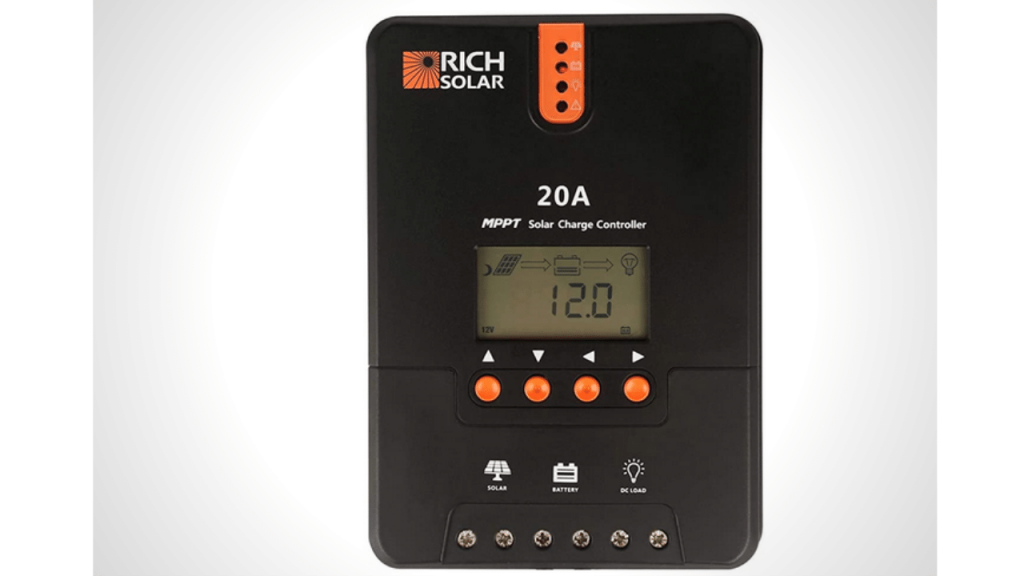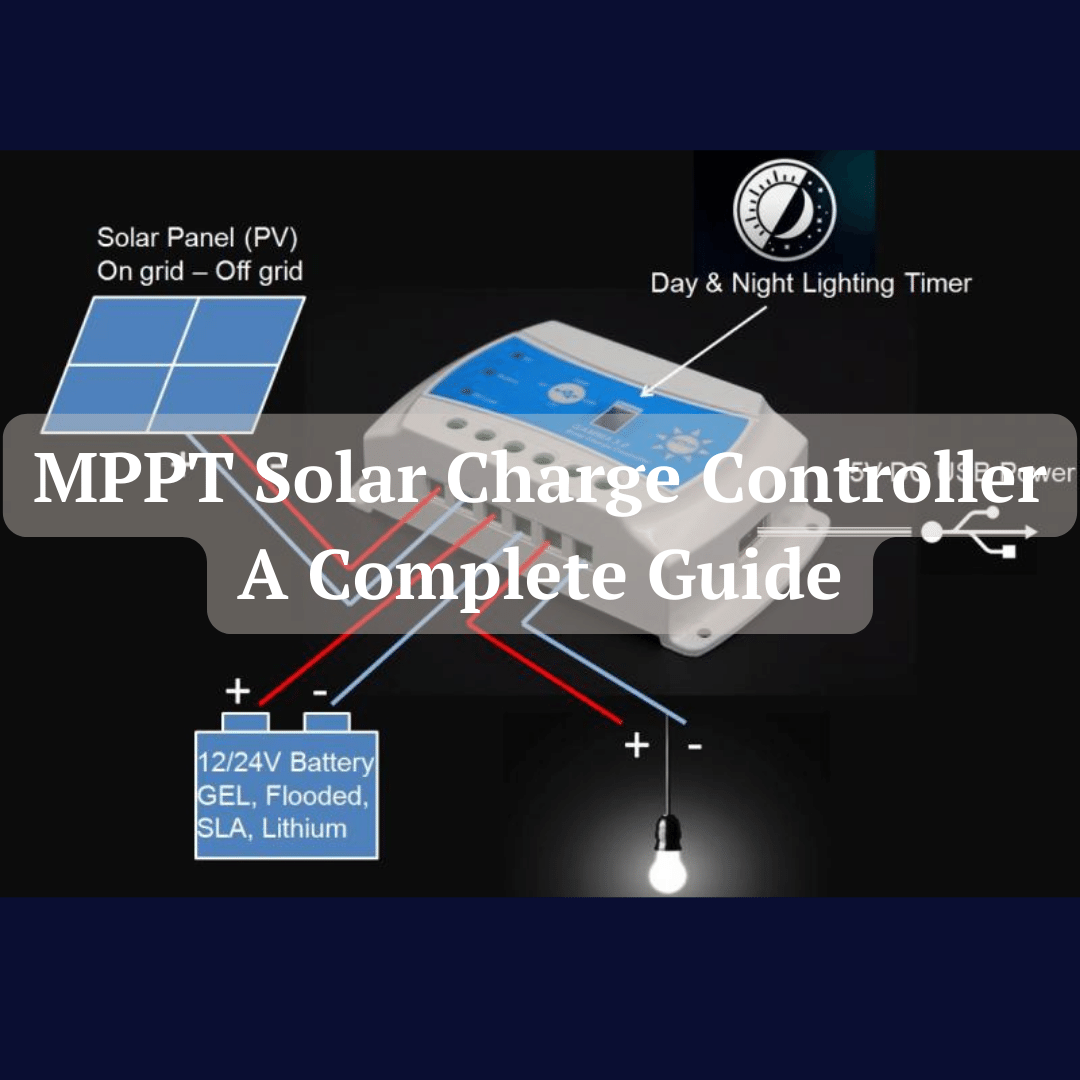Solar Systems are becoming popular day by day. With the ever-increasing electricity bills and regular power outages, people are now switching to solar.
One of the critical parts of a solar energy system is a Solar Inverter; within that is a solar charge controller, which is commonly found in today’s solar power systems. There are two kinds of solar charge controllers- MPPT, maximum power point tracking, and PWM solar charge controllers, pulse width modulation.
A solar charge controller, or a solar regulator, connects the batteries and the solar panels. The primary purpose of it is to regulate the battery charging process. It ensures the battery voltage is adequately charged and not under or over-charged.
For anyone new to maximum power point tracking or solar charge controllers, this guide will help you understand how they work, why it is better, and the best maximum power point tracking solar controllers that one can go for.
What Does an MPPT Charge Controller Do?
Maximum power point tracking or MPPT is an electronic tracking system known as a DC-to-DC converter and will usually come in digital form. The controller’s job is to look at the panels’ output and compare it to the voltage of the battery.
Once the comparison of battery and voltage required is made, the maximum power point tracking or DC converter finds the power that will be right for the panel to put out in order to charge the battery.
After that, it converts the voltage and supplies it to the batteries to its optimum to receive the maximum AMPS.
Modern-day MPPTs are designed to enhance the efficiency of the batteries in mind, which is why they are 93-97% efficient when it comes to voltage conversion. Usually, one can expect to get 20-45% of power gain in the cold weather.
Whereas in high temperatures, it is usually 10-15%. But readers may note that the actual gain will vary depending on the battery state of charge, temperature, weather, and other factors.
The output of the maximum power point tracking charge controller can fluctuate repeatedly, and that happens because MPPT tries to get the maximum amps for the battery. So, it looks for the exact point to convert the voltage/current so that the battery can receive exactly what it requires.
The MPPT controllers can efficiently handle severe weather conditions and preserve battery output to overcome lower voltage problems. Even if there is a voltage drop, the controller will optimize the battery and work without hassle.
Apart from MPPT, the DC converter, another commonly and widely used solar charge controller, is a PWM controller. But PWM controller works differently when connected to the battery of the solar product.
So, a PWM controller will connect the solar array to a battery. However, the PWM controller usually produces low power output when the temperature gets low. Therefore, they are not suitable for large household grid-tie arrays. Moreover, the PWM controller is considered to be outdated.
Also, a PWM controller is better for smaller systems, whereas an MPPT controller is better for larger systems. Therefore, MPPT controllers are now becoming more popular than PWM controllers.
How Does An MPPT work?
The main principle of MPPT is to make the solar inverter or solar panels work efficiently by converting the battery voltage to use the most power, meaning maximum available power. This means that:
MPPT solar charge controllers will look at the output of the solar products in the larger household grid-tie arrays. After understanding what will work the best, it will fix the best power that the solar product can produce to charge the battery.
Simply, it regulates the power transfer between solar panels and batteries. The reason why so many people use a charge controller is that it is energy efficient. It smartly adjusts the input voltage. Moreover, MPPT is better than PWM charge controllers.
Most solar charge controllers, such as a power-point tracking MPPT charge controller, will convert the voltage so the battery can get maximum current. It will hold the voltage after doing bulk charging.
MPPT becomes the most cost-effective under the following conditions:
Cold Weather: The battery bank’s battery capacity with MPPT solar charge controllers enhances more in cold weather. Since winter needs more power, it extracts the maximum power available in solar panels or other solar products.
The battery is Low in Power: MPPT solar charge controllers can charge the battery efficiently when the battery runs low in power. So, when the panel temperature goes down during cold weather, MPPTs work efficiently and with maximum power.
Long Wire Runs: Let’s say you are trying to charge a battery with 12-volt; however, the panels are located at a distance of 100 feet. In this case, what will happen is the voltage will drop along with power loss.
But if you have four 12-volt panels wired in for 48 volts, the MPPT solar charge controller will be able to convert the higher voltage to 12 volts, and the power loss will be less. It will require a smaller wire than a large wire.
Is an MPPT charge controller worth it?

MPPT solar charge controllers can be a better option under some circumstances. For example, MPPT is worth it if the solar system is a large battery. As you know by now, the MPPT charge controller regulates the electricity going into the battery from a solar array.
Also, people thinking of installing solar panels on the roof or buying a large solar power system can go with MPPT charge controllers. Plus, it provides you with the extra power to use later.
It ensures that the battery of the solar product is not overcharged during the day and the product doesn’t send the stored power to the solar panels during the night. Meaning it controls excess voltage.
An MPPT controller is an ideal choice for places with cold temperatures. When the solar module operating system’s temperature decreases, an MPPT controller tries to optimize the module voltage to the highest capacity in order to charge the battery.
And suppose you compare an MPPT controller to a PWM controller. In that case, you will notice that the PWM controller can’t capture excess voltage since it uses a modulation technology that uses the same voltage as the battery to charge it. But, in addition, it works with most panels.
This allows the MPPT controller to work efficiently during cold climates and charge 20-25% more. When it comes to the cost of MPPT controllers, it is cost-effective and is more efficient since they can produce more power under challenging conditions. The only thing one has to consider is where the solar panels are getting installed to optimize the performance of MPPT controllers.
Buying Guide for Maximum Power Point Tracking Systems for Solar Panels
Before choosing an MPPT controller, there are a few things that you should consider for the sizing of off-grid power systems.
Estimate the loads: Consider the amount of energy you usually need in a day. Accordingly, buy the battery bank with the correct output voltage.
Solar Charge Controller Features: While searching for solar charge controllers, think about the features you want the controller to have. For example, do you want the battery to stay protected from getting overcharged, less maintenance, longer battery lifespan, auto charged indication, etc.?
Battery Capacity: Depending on the amount of energy you need daily, you need to decide the battery size accordingly in Ah or Wh. This means that one should take battery voltages and battery types into account.
Solar Panels: The battery size will be able to charge a certain number of solar panels. Hence, decide the number of solar panels you want to charge with the battery. You need to think about the panel voltage.
First, think about the solar appliance that you will need the solar charge controller for. Then, you can calculate the load based on the appliance’s power rating (W) and then multiply it by hr, which is the average runtime.
As discussed, think about the solar charge controllers’ features. Modern-day MPPT controllers come with features. For example, it doesn’t let the batteries get overcharged, reduces the maintenance cost, enhances the battery’s life, comes with auto-charged indication, and more.
While buying a charge controller, focus on the different features each product offers. Also, read the description; it will help you understand the features.
The total Wh or Ah is used when it comes to the batteries’ size. Lead-acid batteries, for example, are sized in Ah. But lithium batteries are sized both in Ah and Wh.
Also, decide the capacity of the batteries based on the number of solar panels you will use. The solar panels should be under full sun to get fully charged. But that may not happen because you can never vouch for the weather. Finally, decide on panel voltage based on battery capacity. But to simplify things, measure the number of watts required to produce 20% of the battery capacity in Amps. So, based on this rule, if you go for a 12V, 200 Ah battery, it will require up to 40 Amps to get charged.
What Are The Best MPPT?
An excellent maximum power point tracker will allow you to save energy and money. But since the market is loaded with MPPT charge controllers, one should be careful about choosing the correct charge controllers that will do their job precisely.
Here are some of the suggestions that you can go for:
1) EPEVER MPPT Charge Controller, 40A 150V PV

EPEVER 40A and 150V MPPT Charge Controller is leading the market because of its battery regulation feature. In addition, EPEVER solar charge controller[1] is cost-effective, and the tracking efficiency is 99.5%. You will find other MPPT of the same brand whose outputs range from 20A to 40A.
If you want to create an off-grid solar panel system, EPEVER will be a good choice. This model’s battery voltage is 12-24 V, with 100V as the maximum input voltage and 30A as the maximum current output.
It also comes with many extra features, such as four-stage battery charging, PC software, LCD screen, and temperature compensation, and it supports multiple load control methods.
It protects against short circuits, over-discharging, reverse current, reverse polarity, and overcharging.
Pros
- The price is reasonable and affordable.
- It has a backlight LCD screen, PC support, and more.
- It prevents reverse current, reverse polarity, short circuits, and more.
- It is well-designed with different load control options.
- It can optimize energy and efficiently charge the battery.
Cons
- When it gets charged, it produces noise.
2) Victron Energy SmartSolar MPPT, SCC110030210

If you want a solar charge controller engineered using cutting-edge technology, choose Victron Energy SCC110030210[2] SmartSolar MPPT. It has multiple battery voltages, such as 12/24/48V.
It gathers energy from the solar panels and efficiently stores it in the batteries. It allows you to remotely monitor the device anywhere you are at home. One can easily install it to the panels, and it can connect up to the 50-foot distance.
It comes with an app that works conveniently. The wire terminals are robust and provide you with live and accurate data. In addition, the built-in Bluetooth technology lets you connect the device to your smartphone.
Pros
- The MPPT controller is designed using cutting-edge technology.
- It enhances and sustains battery life.
- One can remotely monitor the device anywhere in the house.
- The wire terminals are robust.
- The overall construction is fantastic.
Cons
3) EPEVER Tracer 4215BN-MT50 MPPT Charge Controller

Another good MPPT by EPEVER is Tracer4215BN-MT50. Designed with modern and leading technology, it works exceptionally. The innovative tracking algorithm optimizes the energy and lets the battery charge efficiently.
This robust MPPT controller features a wide LED screen which helps you see the real-time operation in textual, digital, and graphic forms. Its tracking efficiency is more than 99.5%. In addition, it can handle more solar panel wiring to lower PV current.
It is equipped with a temperature sensor and PC communication cable. These things allow you to monitor everything efficiently. Therefore, even price-wise, EPEVER Tracer4215BN-MT50 MPPT is a good choice since it is affordable.
Pros
- Backed by advanced power tracking technology.
- It is compatible with multiple battery types.
- The battery temperature and PC communication make monitoring the device efficiently.
- It is equipped with different charging parameter settings.
- It comes with a wide LED screen display.
Cons
- Users have complained that the user manual is not user-friendly.
4) PowMr MPPT Charge Controller

With an energy efficiency of ≥98.1%, PowMr MPPT Charge Controller is a high-performing MPPT device. This affordable option is compatible with many devices and has extra features, such as real-time energy recording, absorption voltage, floating voltage, low voltage disconnect, etc.
It is integrated with a DSP controller and backlight LCD. The troubleshooting function of this MPPT is outstanding. Ensure the battery has 12V+ voltage and enough power to detect itself once it gets linked to the MPPT controller.
It can detect any errors in the system and adjusts the parameters whenever required. The cost of powMr MPPT is not much, provided all the features it offers.
Pros
- PowMr MPPT is an affordable choice.
- It is constructed with updated software.
- User programmable for low voltage disconnect, load timer, etc.
- The charging is excellent and constant.
- It is equipped with a backlight LCD.
Cons
- The user manual is disappointing.
5) RICH SOLAR MPPT Solar Charge Controller

RICH SOLAR MPPT is compatible with different batteries. Whether you have lithium, flooded, gel, or sealed batteries, RICH SOLAR MPPT will efficiently work with them. It is equipped with high tracking efficiency and designed with modern and innovative technology.
It protects the device from overcharging, short circuits, overloading, and over-discharging. In addition, reverse protection ensures that it doesn’t cause any damage to any components. Design-wise, RICH SOLAR MPPT is fantastic.
It has a die-cast aluminum design, can measure the battery’s temperature, and is a good product for remote monitoring. It uses BT-1 to connect with different smartphones. One can download the smartphone app to start using RICH SOLAR MPPT.
Pros
- The die-cast aluminum design is aesthetically appealing.
- It is equipped with a decent size LCD screen.
- The tracking efficiency is 99%, while the conversion efficiency is 98%.
- One can use it for remote monitoring.
- The cost of RICH SOLAR MPPT is affordable.
Cons
- Just like many other MPPTs, the instruction manual is hard to understand.
6) AMPINVT MPPT Solar Charge Controller

AMPINVT MPPT offers a 99% power tracking rate and more than 98% conversion rate. It works with multiple batteries, such as lead-acid, colloidal, and lithium. AMPINVT MPPT can conveniently deal with battery charging problems.
It has a decent LCD size that provides working conditions and operating data. You will receive real-time energy reports with current and daily power generation curves. It troubleshoots issues automatically.
The maximum input voltage is 150V and it comes in different voltages. You can choose a DC input that suits your requirements. It can protect the device against overload, over-discharge, overcharge, short circuit, reverse polarity, and more.
Pros
- It is available in different DC inputs and doesn’t cost much.
- The tracking rate and maximum conversion rate are excellent.
- It can conveniently work with different batteries.
- It is equipped with a decent size LCD that is clear to see.
- It comes with many protections feature.
Cons
- Some users have complained that the manual is not available in English.
7) Autoday-3C MPPT Charge Controller

You may prefer Autoday-3C MPPT Charge Controller if you have a tight budget. But Autoday-3C MPPT works only with lead-acid batteries. When the battery voltage drops, the system will cut off the load automatically from the system.
It can boost its efficiency by 30%, a great feature. In addition, it protects against battery-related, over-charging, over-discharging, reverses charging, and other issues.
It comes with a robust SOC function, and the company’s customer service is fantastic. Users of Auto day-3C MPPT have mentioned that the customer support team is active.
Pros
- It is affordable, and the build quality is good too.
- It can boost efficiency to 30%.
- The SOC function is impressive.
- The customer service team is good.
- It prevents the battery from over-discharging, overcharging, etc.
Cons
- Some users have complained that the wires/cables don’t stay in place.
Conclusion
MPPT charge controllers are an excellent option to go for. First, choose an MPPT controller that will work well with different batteries and will allow you to save more energy.
Therefore, buy an MPPT controller based on your research. This article has already highlighted good quality MPPT controllers but ensures to research about each of them.

